The Toyota Land Cruiser and Land Rover Defender are two of the most iconic off-road vehicles on the market today. Both models have earned their reputations for durability, capability, and adventure, making them favorites among wilderness enthusiasts and urban dwellers alike. In this comparison, we will dive into the technical aspects and innovations that set these two off-road titans apart.
Toyota Land Cruiser vs Land Rover Defender – Differences & prices compared
Two cars, one duel: Toyota Land Cruiser meets Land Rover Defender.
Which one wins in performance, efficiency and value for money? Find out now!
Performance and Powertrains
The 2024 Toyota Land Cruiser is powered by a robust 2.8-liter diesel engine that produces 205 horsepower and 500 Nm of torque. This efficient powertrain is paired with an automatic transmission, allowing for smooth shifts and impressive all-wheel drive capabilities. Its fuel consumption sits at 10.3 L/100km, and it achieves a maximum speed of 170 km/h. The Land Cruiser also boasts a reasonable curb weight of 2410 kg, contributing to its balance of strength and agility.
On the other hand, the Land Rover Defender offers a diverse range of engine options, including diesel MHEV and petrol variants. The Defender’s engines range from 200 HP to a staggering 525 HP, showcasing a breadth of choices for consumers with different performance preferences. The Defender can accelerate from 0 to 100 km/h in as little as 5.2 seconds, thanks to its powerful 5.0-liter V8 option. Fuel consumption varies depending on the engine selected, with options as efficient as 8.3 L/100km.
Technology and Innovations
Both vehicles are equipped with cutting-edge technology, but they take different approaches. The Toyota Land Cruiser focuses on reliability and traditional off-road prowess. Features like the Multi-Terrain Select system and Crawl Control help drivers navigate challenging terrain with ease. Its interior is spacious, offering comfortable seating for up to five passengers and plenty of room for luggage—742 liters of trunk capacity enhances its practicality.
In contrast, the Land Rover Defender embraces modernity with its innovative technologies and features. Its infotainment system is centered around the Pivi Pro interface, a user-friendly system that integrates seamlessly with smartphones and includes advanced navigation and off-road navigation aids. The Defender’s commitment to sustainability is evident with its Plug-in Hybrid option that provides an electric range of up to 45 km. Not to mention the luxurious finishes available, which elevate the driving experience beyond mere utility.
Dimensions and Comfort
When comparing dimensions, the Land Cruiser measures 4925 mm in length and stands 1935 mm tall, offering a commanding presence on and off the road. The spacious interior accommodates five passengers comfortably. Its width is 1980 mm, providing a sturdy stance that translates well into its off-road capability.
Meanwhile, the Land Rover Defender comes in various sizes, with the longest variant measuring 5358 mm. This flexibility, which includes configurations for five, eight, or even two passengers, gives buyers the option to choose a model that best suits their lifestyle. The Defender’s height ranges between 1967 mm and 1974 mm, and its width comes in at 2008 mm, emphasizing space and comfort in a rugged package.
Final Thoughts
In the ultimate showdown between the Toyota Land Cruiser and Land Rover Defender, it ultimately depends on what you value most in an off-road vehicle. The Land Cruiser is a stalwart of reliability and traditional off-road capability, suitable for enthusiasts who appreciate a tried-and-true model. Alternatively, the Defender's blend of cutting-edge technology, versatility, and powerful performance makes it a compelling choice for those looking for modern innovations alongside rugged capability. The decision between these two formidable off-road icons may hinge on personal preference, but both options offer unparalleled adventure-ready capabilities.
Here’s where it gets real: The technical differences in detail
Costs and Efficiency:
Price and efficiency are often the first things buyers look at. Here it becomes clear which model has the long-term edge – whether at the pump, the plug, or in purchase price.
Land Rover Defender has a hardly perceptible advantage in terms of price – it starts at 57900 £, while the Toyota Land Cruiser costs 58300 £. That’s a price difference of around 420 £.
Fuel consumption also shows a difference: Land Rover Defender manages with 6 L and is therefore clearly more efficient than the Toyota Land Cruiser with 10.30 L. The difference is about 4.30 L per 100 km.
Engine and Performance:
Power, torque and acceleration are the classic benchmarks for car enthusiasts – and here, some clear differences start to show.
When it comes to engine power, the Land Rover Defender has a decisively edge – offering 635 HP compared to 205 HP. That’s roughly 430 HP more horsepower.
In terms of top speed, the Land Rover Defender performs noticeable better – reaching 250 km/h, while the Toyota Land Cruiser tops out at 170 km/h. The difference is around 80 km/h.
There’s also a difference in torque: Land Rover Defender pulls noticeable stronger with 750 Nm compared to 500 Nm. That’s about 250 Nm difference.
Space and Everyday Use:
Cabin size, boot volume and payload all play a role in everyday practicality. Here, comfort and flexibility make the difference.
Seats: Land Rover Defender offers somewhat more seating capacity – 8 vs 7.
In curb weight, Land Rover Defender is hardly perceptible lighter – 2300 kg compared to 2410 kg. The difference is around 110 kg.
In terms of boot space, the Land Rover Defender offers slight more room – 786 L compared to 742 L. That’s a difference of about 44 L.
In maximum load capacity, the Land Rover Defender performs minimal better – up to 2078 L, which is about 78 L more than the Toyota Land Cruiser.
When it comes to payload, Land Rover Defender to a small extent takes the win – 819 kg compared to 690 kg. That’s a difference of about 129 kg.
Who comes out on top?
Overall, the Land Rover Defender shows itself to be outperforms in nearly all aspects and secures the title of DriveDuel Champion.
It convinces with the more balanced overall package and proves to be the more versatile choice for everyday use.
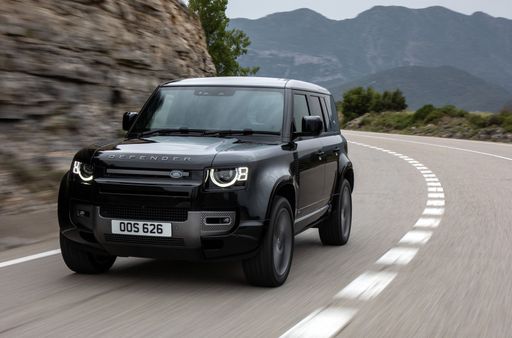 @ Jaguar Land Rover Media
@ Jaguar Land Rover Media
Land Rover Defender
Toyota Land Cruiser
The Toyota Land Cruiser is renowned for its robust durability and exceptional off-road capabilities. Its design combines a rugged exterior with a comfortable and functional interior, appealing to both adventure seekers and city drivers. The vehicle's reliability and advanced technology make it a popular choice for those who require a dependable SUV that can handle a variety of terrains with ease.
details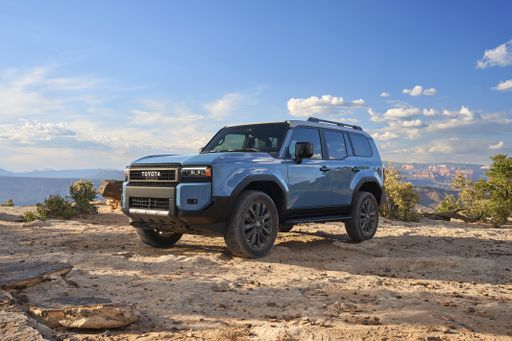 @ Toyota Motor Corporation
@ Toyota Motor Corporation
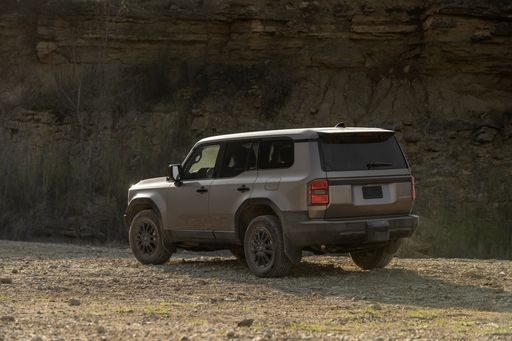 @ Toyota Motor Corporation
@ Toyota Motor Corporation
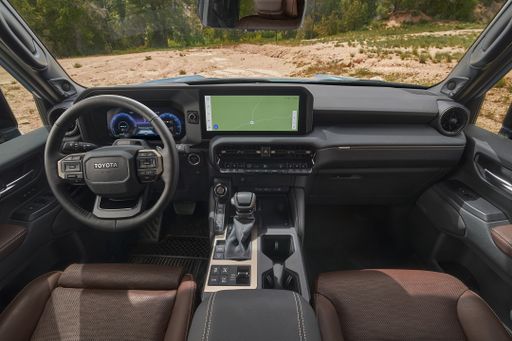 @ Toyota Motor Corporation
@ Toyota Motor Corporation
Land Rover Defender
The Land Rover Defender boasts a rugged design that seamlessly blends traditional aesthetics with modern innovation, making it a true icon in the world of off-road vehicles. Its performance capabilities are matched by a luxurious interior, offering comfort and cutting-edge technology for drivers and passengers alike. Whether tackling rough terrains or cruising through city streets, the Defender exudes versatility and reliability, maintaining its reputation as a robust yet refined companion for any adventure.
details @ Jaguar Land Rover Media
@ Jaguar Land Rover Media
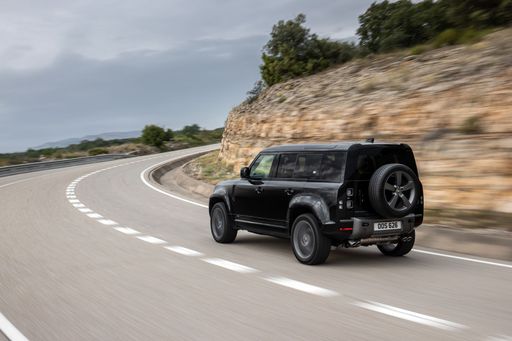 @ Jaguar Land Rover Media
@ Jaguar Land Rover Media
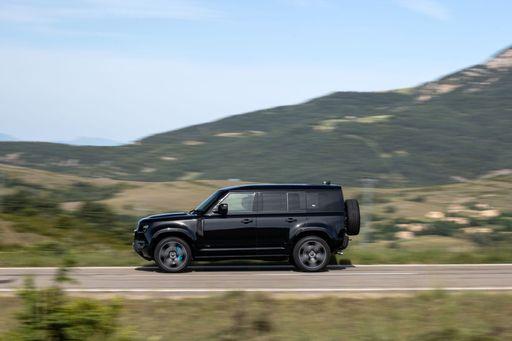 @ Jaguar Land Rover Media
@ Jaguar Land Rover Media
 @ Jaguar Land Rover Media
@ Jaguar Land Rover Media
 @ Jaguar Land Rover Media
@ Jaguar Land Rover Media
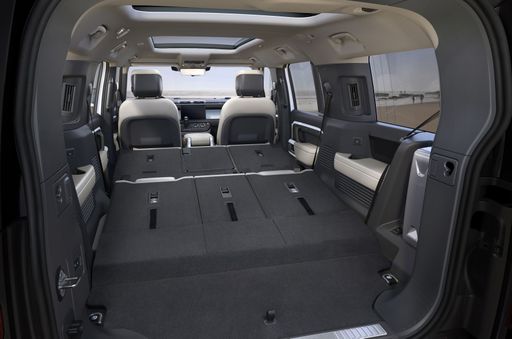 @ Jaguar Land Rover Media
@ Jaguar Land Rover Media
 @ Toyota Motor Corporation
@ Toyota Motor Corporation
|
 @ Jaguar Land Rover Media
@ Jaguar Land Rover Media
|
|
|
|
Costs and Consumption |
|
|---|---|
|
Price
58300 - 78400 £
|
Price
57900 - 172000 £
|
|
Consumption L/100km
10.30 L
|
Consumption L/100km
6 - 14.4 L
|
|
Consumption kWh/100km
-
|
Consumption kWh/100km
-
|
|
Electric Range
-
|
Electric Range
48 km
|
|
Battery Capacity
-
|
Battery Capacity
15.40 kWh
|
|
co2
272 g/km
|
co2
135 - 324 g/km
|
|
Fuel tank capacity
80 L
|
Fuel tank capacity
89 - 91 L
|
Dimensions and Body |
|
|---|---|
|
Body Type
Off-Roader
|
Body Type
Off-Roader
|
|
Seats
5 - 7
|
Seats
2 - 8
|
|
Doors
5
|
Doors
3 - 5
|
|
Curb weight
2410 - 2550 kg
|
Curb weight
2300 - 2745 kg
|
|
Trunk capacity
130 - 742 L
|
Trunk capacity
293 - 786 L
|
|
Length
4925 mm
|
Length
4323 - 5358 mm
|
|
Width
1980 mm
|
Width
2008 mm
|
|
Height
1935 mm
|
Height
1967 - 1995 mm
|
|
Max trunk capacity
1875 - 2000 L
|
Max trunk capacity
1263 - 2078 L
|
|
Payload
600 - 690 kg
|
Payload
494 - 819 kg
|
Engine and Performance |
|
|---|---|
|
Engine Type
Diesel
|
Engine Type
Petrol, Diesel MHEV, Plugin Hybrid, Petrol MHEV
|
|
Transmission
Automatic
|
Transmission
Automatic
|
|
Transmission Detail
Automatic Gearbox
|
Transmission Detail
Automatic Gearbox
|
|
Drive Type
All-Wheel Drive
|
Drive Type
All-Wheel Drive
|
|
Power HP
205 HP
|
Power HP
200 - 635 HP
|
|
Acceleration 0-100km/h
-
|
Acceleration 0-100km/h
4 - 10.2 s
|
|
Max Speed
170 km/h
|
Max Speed
175 - 250 km/h
|
|
Torque
500 Nm
|
Torque
500 - 750 Nm
|
|
Number of Cylinders
4
|
Number of Cylinders
4 - 8
|
|
Power kW
151 kW
|
Power kW
147 - 467 kW
|
|
Engine capacity
2755 cm3
|
Engine capacity
1997 - 5000 cm3
|
General |
|
|---|---|
|
Model Year
2024
|
Model Year
2025
|
|
CO2 Efficiency Class
G
|
CO2 Efficiency Class
G, D
|
|
Brand
Toyota
|
Brand
Land Rover
|
What drivetrain options does the Toyota Land Cruiser have?
The Toyota Land Cruiser is offered with All-Wheel Drive.
The prices and data displayed are estimates based on German list prices and may vary by country. This information is not legally binding.
